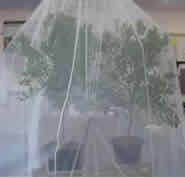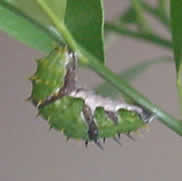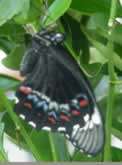
During the summer months (Australia,during term 1 and 4) no artificial heating is necessary. The insects (caterpillars) feed on common citrus leaves. Lemon tree cuttings will suffice, but make sure they have not been sprayed with insecticide. The ideal way to keep caterpillars of the Orchard butterfly is to place them on a potted kumquat tree. Place the tree in the classroom and hang a mosquito net over the tree as shown in the picture on the left. Students can enter the net and observe the life cycle in action. When the butterflies emerge the fun really starts.
|
Avoid handling the caterpillars where possible. To transfer the caterpillars from tree to tree simply cut the leaf they are on and secure it with a paper clip to the new tree. If you are using lemon tree cuttings, place the cuttings in a thin necked bottle . Take care to cover the entry to the bottle as the caterpillars will crawl into the water and drown. Place them in a disused aquarium and make sure the leaves do not touch the sides of the enclosure as the insects will crawl off their food source. Always change the leaves every second day. Lemon leaves will dry quickly and it is important to always supply fresh leaves. |
|
When the caterpillar has attached itself to the branch, as |


When the butterfly emerges, allow it to hang in order to expand and dry its wings. The butterfly will survive for a period of one to two weeks. The butterfly has little need for food. Its function is to mate. A concentrated sugar solution placed in the middle of a dry flower will suffice.
YOU CAN ORDER LARVAE (caterpillars) from
DYNAMIC SCIENCE EDUCATION
(61 03 9560 7540)
Australian customers ONLY.